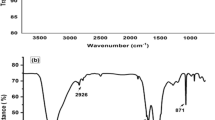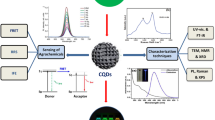Abstract
A fast, effective, and sensitive dispersive solid-phase microextraction method coupled with ion mobility spectrometry for the simultaneous determination of bendiocarb, butachlor, and diazinon was developed using zinc sulfide/sulfur/sulfur-doped reduced graphene oxide (ZnS/S/S-RGO) nanocomposites. ZnS/S/S-RGO three-component nanocomposites were synthesized through a single-step solvothermal procedure, and their properties were characterized by FT-IR, XRD, X-ray photoelectron spectroscopy (XPS), field emission scanning electron microscopy (FESEM), and energy-dispersive x-ray spectroscopy (EDX). The influence of different parameters was optimized on the efficiency of the extraction including the type and the volume of desorption solvent, pH, type and the volume of buffer, the amount of absorbent, sorption and desorption times. Under the optimal conditions, linear ranges were achieved 0.8–110, 1.0–110, and 0.5–100 ng mL−1 with detection limits of 0.32±0.01, 0.40±0.02, and 0.27±0.02 ng mL−1 for bendiocarb, butachlor, and diazinon, respectively. The method was employed for the ultra-trace determination of the three pesticides in water, rice, and soil samples with acceptable recovery values within the range 96.6±4.8–104.4±6.4%.
Graphical abstract




Similar content being viewed by others
References
Demir Ö, Ulusoy Hİ, Özer ET, Osman B (2020) Development of a new solid phase extraction method for sensitive determination of some carbamate pesticides in water using poly(EGDMA-MATrp) microbeads. Microchem J 158: https://doi.org/10.1016/j.microc.2020.105317
Ghoraba Z, Aibaghi B, Soleymanpour A (2018) Ultrasound-assisted dispersive liquid-liquid microextraction followed by ion mobility spectrometry for the simultaneous determination of bendiocarb and azinphos-ethyl in water, soil, food and beverage samples. Ecotoxicol Environ Saf. https://doi.org/10.1016/j.ecoenv.2018.09.021
Canlı AG, Sürücü B, Ibrahim UH et al (2019) Molecules analytical methodology for trace determination of propoxur and fenitrothion pesticide residues by. Molecules 24:1–15
Musarurwa H, Tavengwa NT (2021) Deep eutectic solvent-based dispersive liquid-liquid micro-extraction of pesticides in food samples. Food Chem 342:127943. https://doi.org/10.1016/j.foodchem.2020.127943
Ulusoy Hİ, Köseoğlu K, Kabir A, et al (2020) Fabric phase sorptive extraction followed by HPLC-PDA detection for the monitoring of pirimicarb and fenitrothion pesticide residues. Microchim Acta 187: https://doi.org/10.1007/s00604-020-04306-7
Mirzajani R, Kardani F, Ramezani Z (2020) Fabrication of UMCM-1 based monolithic and hollow fiber – metal-organic framework deep eutectic solvents/molecularly imprinted polymers and their use in solid phase microextraction of phthalate esters in yogurt, water and edible oil by GC-FID. Food Chem 314:126179. https://doi.org/10.1016/j.foodchem.2020.126179
Nemati M, Farajzadeh MA, Mohebbi A et al (2020) Development of a stir bar sorptive extraction method coupled to solidification of floating droplets dispersive liquid–liquid microextraction based on deep eutectic solvents for the extraction of acidic pesticides from tomato samples. J Sep Sci 43:1119–1127. https://doi.org/10.1002/jssc.201901000
Kemmerich M, Demarco M, Bernardi G, et al (2020) Balls-in-tube matrix solid phase dispersion (BiT-MSPD): an innovative and simplified technique for multiresidue determination of pesticides in fruit samples. J Chromatogr A 1612: https://doi.org/10.1016/j.chroma.2019.460640
Medina DAV, Rodríguez Cabal LF, Titato GM et al (2019) Automated online coupling of robot-assisted single drop microextraction and liquid chromatography. J Chromatogr A 1595:66–72. https://doi.org/10.1016/j.chroma.2019.02.036
Chao Y, Pang J, Bai Y et al (2020) Graphene-like BN@SiO2 nanocomposites as efficient sorbents for solid-phase extraction of Rhodamine B and Rhodamine 6G from food samples. Food Chem 320:126666. https://doi.org/10.1016/j.foodchem.2020.126666
Tanveer ZI, Huang Q, Liu L et al (2020) Reduced graphene oxide-zinc oxide nanocomposite as dispersive solid-phase extraction sorbent for simultaneous enrichment and purification of multiple mycotoxins in Coptidis rhizoma (Huanglian) and analysis by liquid chromatography tandem mass spectrometry. J Chromatogr A 1630. https://doi.org/10.1016/j.chroma.2020.461515
Rejczak T, Tuzimski T (2015) A review of recent developments and trends in the QuEChERS sample preparation approach. Open Chem 13:980–1010. https://doi.org/10.1515/chem-2015-0109
Ahmadi M, Elmongy H, Madrakian T, Abdel-Rehim M (2017) Nanomaterials as sorbents for sample preparation in bioanalysis: a review. Anal Chim Acta 958:1–21
Darvishnejad M, Ebrahimzadeh H (2017) Halloysite nanotubes functionalized with a nanocomposite prepared from reduced graphene oxide and polythiophene as a viable sorbent for the preconcentration of six organochlorine pesticides prior to their quantitation by GC/MS. Microchim Acta 184:3603–3612. https://doi.org/10.1007/s00604-017-2381-2
Ayazi Z (2017) Application of nanocomposite-based sorbents in microextraction techniques: a review. Analyst 142:721–739. https://doi.org/10.1039/c6an02744j
Sun T, Fan Y, Fan P et al (2019) Use of graphene coated with ZnO nanocomposites for microextraction in packed syringe of carbamate pesticides from juice samples. J Sep Sci 42:2131–2139. https://doi.org/10.1002/jssc.201900257
Talebianpoor MS, Khodadoust S, Mousavi A et al (2017) Preconcentration of carbamate insecticides in water samples by using modified stir bar with ZnS nanoparticles loaded on activated carbon and their HPLC determination: response surface methodology. Microchem J 130:64–70. https://doi.org/10.1016/j.microc.2016.08.002
Queiroz RN, Prediger P, Vieira MGA (2022) Adsorption of polycyclic aromatic hydrocarbons from wastewater using graphene-based nanomaterials synthesized by conventional chemistry and green synthesis: a critical review. J Hazard Mater 422
Bajpai VK, Shukla S, Khan I et al (2019) A sustainable graphene aerogel capable of the adsorptive elimination of biogenic amines and bacteria from soy sauce and highly efficient cell proliferation. ACS Appl Mater Interfaces 11:43949–43963. https://doi.org/10.1021/acsami.9b16989
Ghoraba Z, Aibaghi B, Soleymanpour A (2017) Application of cation-modified sulfur nanoparticles as an efficient sorbent for separation and preconcentration of carbamazepine in biological and pharmaceutical samples prior to its determination by high-performance liquid chromatography. J Chromatogr B Anal Technol Biomed Life Sci 1063:245–252. https://doi.org/10.1016/j.jchromb.2017.07.048
Ghanemi K, Nikpour Y, Omidvar O, Maryamabadi A (2011) Sulfur-nanoparticle-based method for separation and preconcentration of some heavy metals in marine samples prior to flame atomic absorption spectrometry determination. Talanta 85:763–769. https://doi.org/10.1016/j.talanta.2011.04.066
Moshari M, Mehrehjedy A, Heidari-Golafzania M et al (2021) Adsorption study of lead ions onto sulfur/reduced graphene oxide composite. Chem Data Collect 31:100627. https://doi.org/10.1016/j.cdc.2020.100627
Zhang L, Wang C, Li Z et al (2018) Extraction of acetanilides in rice using ionic liquid-based matrix solid phase dispersion-solvent flotation. Food Chem 245:1190–1195. https://doi.org/10.1016/j.foodchem.2017.11.029
Lee J, Kim L, Shin Y et al (2017) Rapid and simultaneous analysis of 360 pesticides in brown rice, spinach, orange, and potato using microbore GC-MS/MS. J Agric Food Chem 65:3387–3395. https://doi.org/10.1021/acs.jafc.7b00576
Kashinath L, Namratha K, Byrappa K (2017) Sol-gel assisted hydrothermal synthesis and characterization of hybrid ZnS-RGO nanocomposite for efficient photodegradation of dyes. J Alloys Compd 695:799–809. https://doi.org/10.1016/j.jallcom.2016.10.063
Shervedani RK, Amini A (2014) Carbon black/sulfur-doped graphene composite prepared by pyrolysis of graphene oxide with sodium polysulfide for oxygen reduction reaction. Electrochim Acta 142:51–60. https://doi.org/10.1016/j.electacta.2014.07.108
Fantauzzi M, Elsener B, Atzei D et al (2015) Exploiting XPS for the identification of sulfides and polysulfides. RSC Adv 5:75953–75963. https://doi.org/10.1039/c5ra14915k
Sadat SAA, Ilbeigi V, Valadbeigi Y, Soleimani M (2020) Determination of pesticides phosalone and diazinon in pistachio using ion mobility spectrometry. Int J Ion Mobil Spectrom 23:127–131. https://doi.org/10.1007/s12127-020-00262-3
Cheng X, Yan H, Wang X et al (2014) Vortex-assisted magnetic dispersive solid-phase microextraction for rapid screening and recognition of dicofol residues in tea products. Food Chem 162:104–109. https://doi.org/10.1016/j.foodchem.2014.04.023
Kaur R, Goyal D, Agnihotri S (2021) Chitosan/PVA silver nanocomposite for butachlor removal: fabrication, characterization, adsorption mechanism and isotherms. Carbohydr Polym 262:117906. https://doi.org/10.1016/j.carbpol.2021.117906
Shamsizadeh Z, Ehrampoush MH, Dehghani Firouzabadi Z et al (2020) Fe3O4@SiO2 magnetic nanocomposites as adsorbents for removal of diazinon from aqueous solution: isotherm and kinetic study. Pigment Resin Technol 49:457–464. https://doi.org/10.1108/PRT-02-2020-0010
Zali S, Jalali F, Es-haghi A, Shamsipur M (2015) Electrospun nanostructured polystyrene as a new coating material for solid-phase microextraction: application to separation of multipesticides from honey samples. J Chromatogr B Anal Technol Biomed Life Sci 1002:387–393. https://doi.org/10.1016/j.jchromb.2015.07.061
Gure A, Megersa N, Retta N (2014) Ion-pair assisted liquid-liquid extraction for selective separation and analysis of multiclass pesticide residues in environmental waters. Anal Methods 6:4633–4642. https://doi.org/10.1039/c4ay00285g
Xie J, Liu T, Song G et al (2013) Simultaneous analysis of organophosphorus pesticides in water by magnetic solid-phase extraction coupled with GC-MS. Chromatographia 76:535–540. https://doi.org/10.1007/s10337-013-2408-8
Bazmandegan-Shamili A, Dadfarnia S, Haji Shabani AM et al (2016) High-performance liquid chromatographic determination of diazinon after its magnetic dispersive solid-phase microextraction using magnetic molecularly imprinted polymer. Food Anal Methods 9:2621–2630. https://doi.org/10.1007/s12161-016-0456-z
Khodadoust S, Ghaedi M, Hadjmohammadi MR (2013) Dispersive nano solid material-ultrasound assisted microextraction as a novel method for extraction and determination of bendiocarb and promecarb: response surface methodology. Talanta 116:637–646. https://doi.org/10.1016/j.talanta.2013.07.013
Khammas Z, Ahmad S (2015) Micelle-mediating extraction combined with visible spectrophotometry for the determination of ultra trace amounts of bendiocarb insecticide in various matrices after oxidative coupling with O-toluidine. Int Res J Pure Appl Chem 10:1–16. https://doi.org/10.9734/irjpac/2016/21948
Aladaghlo Z, Fakhari A, Behbahani M (2016) Efficient sample preparation method based on solvent-assisted dispersive solid-phase extraction for the trace detection of butachlor in urine and waste water samples. J Sep Sci 39:3798–3805. https://doi.org/10.1002/jssc.201600735
Haddadi H, Rezaee M, Semnani A, Mashayekhi HA (2013) Application of homogeneous liquid-liquid microextraction via flotation assistance followed by gas chromatography for determination of butachlor in water samples. Bull Chem Soc Jpn 86:1282–1286. https://doi.org/10.1246/bcsj.20130175
Li Z, Bai S, Hou M et al (2013) Magnetic graphene nanoparticles for the preconcentration of chloroacetanilide herbicides from water samples prior to determination by GC-ECD. Anal Lett 46:1012–1024. https://doi.org/10.1080/00032719.2012.745086
Acknowledgements
The authors are thankful to the Research Council of Damghan University for financial support of this work and also acknowledge the Golsam Gorgan Chemicals Company of Iran for donating the pesticides.
Funding
This work was supported by Damghan University, Iran.
Author information
Authors and Affiliations
Contributions
Sedigheh Rahmani: conceptualization, methodology, validation, investigation, data curation, visualization, and writing (original draft preparation) and writing (reviewing and editing).
Behzad Aibaghi: supervision, conceptualization, methodology, resources, investigation, reviewing and editing, project administration, and funding acquisition.
Corresponding author
Ethics declarations
Conflict of interest
The authors declare no competing interests.
Additional information
Publisher’s note
Springer Nature remains neutral with regard to jurisdictional claims in published maps and institutional affiliations.
Supplementary Information
ESM 1
(DOCX 787 kb)
Rights and permissions
About this article
Cite this article
Rahmani, S., Aibaghi, B. Application of ZnS/S/S-RGO three-component nanocomposites in dispersive solid-phase microextraction coupled with ion mobility spectrometry for ultra-trace determination of multiclass pesticides. Microchim Acta 189, 9 (2022). https://doi.org/10.1007/s00604-021-05116-1
Received:
Accepted:
Published:
DOI: https://doi.org/10.1007/s00604-021-05116-1




